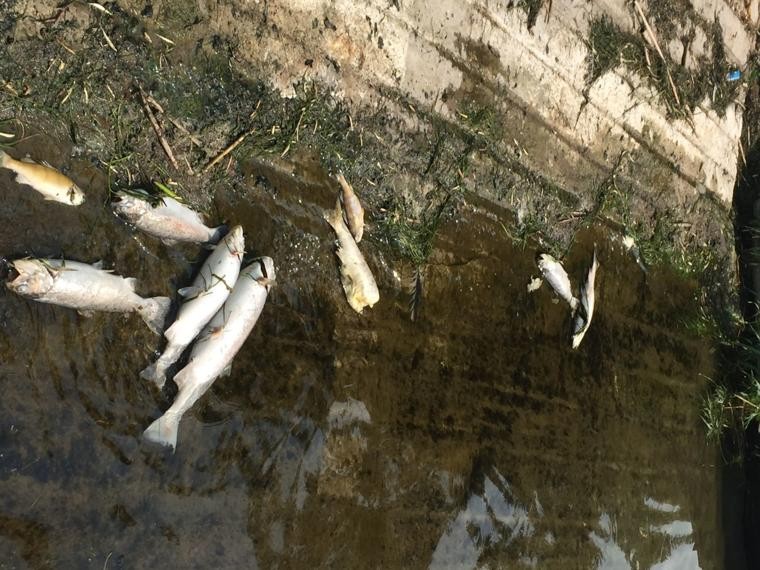AMERICAN FALLS — The Snake River’s banks were littered with several species of dead trophy fish when David Raisch floated the reach below American Falls Dam throughout Saturday.
“I observed multiple sturgeon that were just gasping for air, including some that were 5 feet long,” said Raisch, who works as a fly fishing guide with Palisades Creek Lodge.
Sources with the Idaho Department of Fish and Game say hundreds of trout, small-mouth bass and yellow perch and at least 10 sturgeon were victims of a fish-kill spanning from the dam to the Vista boat ramp and Pipeline area. It was apparently triggered when dissolved oxygen levels plummeted from late Thursday to early Friday.
Fish and Game officials anticipate delayed mortality may continue throughout the next few days.
The cause of the oxygen drop remains under investigation, but sources with the Idaho Department of Environmental Quality have a theory, which is supported by Fish and Game biologists. Lynn Van Every, DEQ’s regional water quality manager, said a prolonged period of hot and calm weather likely resulted in a layer of warm water trapping colder water devoid of dissolved oxygen. Strong winds within the reservoir likely blew the warm water layer upstream from the dam, allowing only the cold water to enter the dam’s penstocks — large pipes that feed Idaho Power turbines.
The cold-water surge lowered oxygen levels below the dam to the point that fish began to die. Van Every confirmed Idaho Power met the conditions of its permits to operate the dam and won’t be fined.
“It happened in relatively short order,” Van Every said. “It’s not uncommon to have low dissolved oxygen coming through, but it sort of happened in a hurry.”
Raisch fished the same reach on Friday night. Though he considered it odd that he had no bites, he didn’t notice the fish-kill until the following morning. He contacted Fish and Game to report the fish-kill after his Saturday float, also describing how surviving trout and smallmouth bass acted “as if they’d had a stroke.”
“It’s a heart-breaker,” Raisch said. “It takes a long time to build those good resources and trophy fishing.”
Dave Teuscher, regional fisheries manager with Idaho Fish and Game, said sensors within the dam and 150 yards downstream constantly monitor dissolved oxygen content, which is considered healthy for fish at levels of above 5 milligrams per liter. Teuscher explained the sensors detected levels dropping from 5 milligrams per liter to zero from 10 p.m. Thursday to midnight Friday. The sensors automatically triggered a blower to activate and oxygenate water flowing from the first penstock. A second blower activated when dissolved oxygen levels hadn’t sufficiently recovered a few minutes later. Ultimately, an alarm signaled Idaho Power staff to respond and open a spillway to add more oxygen.
“Everything Idaho Power has in their water-quality requirements occurred, and that was helpful because this thing could have really turned into a larger fish-kill if that hadn’t happened,” Teuscher said.
DEQ responded to the scene on Sunday, and a Fish and Game crew conducted analysis on Monday morning. On Tuesday afternoon, Fish and Game staff manned a boat, scouring for dead sturgeon to gather biological data, such as growth rate and age.
Some of the sturgeon that were killed were in excess of 30 years old, Teuscher said. The department started stocking them in the reach in the 1980s for catch-and-release fishing and has been stocking the river upstream from American Falls to Idaho Falls more recently.
Idaho’s sturgeon are considered a species of greatest conservation need.
Though Idaho Power was in compliance with its license and obligations to operate the hydro-power turbines, Brad Bowlin said the company will, nonetheless, partner with DEQ and Fish and Game to analyze weather data, incoming flows, oxygen levels and other factors to determine “if there’s something we need to do to our operations.”
Bowlin said Idaho Power hopes to discover what conditions were different during that four-hour period that could aid in forecasting to avoid future problems.
“That was the big issue, that this happened in such a short period of time,” Bowlin said.
Larry Larsen, owner of Snake River Fly Shop in Pocatello, said the Snake River below American Falls is blue-ribbon water utilized by countless anglers and key to his business’s success. In late July, he said the reach was fishing better than during any period in the past five years. But Larsen is also glad the damage wasn’t greater and is already hearing reports that the fishery is recovering.
“I had a customer come in who was fishing there this morning, and he was catching fish,” Larsen said.



